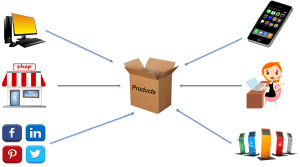NRF 2015: Big Data, Inventory Centralization, and the Cloud
 Another year, another NRF Big Show in the books. Not surprisingly, the typical buzz words were thrown around a lot again this year – omni-channel, integration, mobile, etc. But there were three main themes that popped up in just about every meeting I sat through, and I could hear people talking about them as they walked the floor: big data, inventory centralization, and the cloud. These three themes were everywhere, and for good reason. As retail continues its journey to become omni-channel (when can we just call it commerce?), these are three pillars that continue to drive innovation.
Another year, another NRF Big Show in the books. Not surprisingly, the typical buzz words were thrown around a lot again this year – omni-channel, integration, mobile, etc. But there were three main themes that popped up in just about every meeting I sat through, and I could hear people talking about them as they walked the floor: big data, inventory centralization, and the cloud. These three themes were everywhere, and for good reason. As retail continues its journey to become omni-channel (when can we just call it commerce?), these are three pillars that continue to drive innovation. Big data means a lot of things to a lot of people, but it is certainly not going away. At NRF this year, big data was a prominent figure in the advancement of omni-channel operations. The main focus is on actionable insights. There is so much data available and more is created every day. The problem is determining which data can be used, and how it can be used. Retailers are relying on vast amounts of customer data to drive personalization in marketing campaigns. But they are also using customer data to map out customer segments and tie inventory and assortment planning models to their stores, warehouses, and distribution centers. Data is at the heart of establishing proper assortments – from styles and colors to sizes and materials. Data taken from product performance is also tied to assortment and inventory plans. As retailers know which items have historically sold well, and when they have sold, they can plan their purchase lifecycles accordingly. Additionally, they can evaluate back-up products which may have similar attributes and could act as replacements if they are unable to stock the item they are seeking.
Big data means a lot of things to a lot of people, but it is certainly not going away. At NRF this year, big data was a prominent figure in the advancement of omni-channel operations. The main focus is on actionable insights. There is so much data available and more is created every day. The problem is determining which data can be used, and how it can be used. Retailers are relying on vast amounts of customer data to drive personalization in marketing campaigns. But they are also using customer data to map out customer segments and tie inventory and assortment planning models to their stores, warehouses, and distribution centers. Data is at the heart of establishing proper assortments – from styles and colors to sizes and materials. Data taken from product performance is also tied to assortment and inventory plans. As retailers know which items have historically sold well, and when they have sold, they can plan their purchase lifecycles accordingly. Additionally, they can evaluate back-up products which may have similar attributes and could act as replacements if they are unable to stock the item they are seeking. Looking at assortment and inventory planning, a second main theme at NRF was centralizing inventory. In some recent research, Clint Reiser and I talked about the importance of distributed order management (DOM) for the future of commerce. The advantage of DOM is that it doesn’t matter where an order originates. All fulfillment channels have access to the information and the retailer can appropriately allocate the inventory depending on stock levels, demand requirements, and timing of fulfillment. This is what I kept hearing at NRF. Software suppliers are ensuring that their order management and inventory management solutions are centralizing inventory, allowing all channels to fulfill orders as needed. A big component of this is in-store fulfillment of e-commerce orders. Many conversations moved into this realm, as software solution providers are trying to keep up with the demand of retailers. Big data ties in heavily, as retailers are basing their inventory plans on data and analytics.
Looking at assortment and inventory planning, a second main theme at NRF was centralizing inventory. In some recent research, Clint Reiser and I talked about the importance of distributed order management (DOM) for the future of commerce. The advantage of DOM is that it doesn’t matter where an order originates. All fulfillment channels have access to the information and the retailer can appropriately allocate the inventory depending on stock levels, demand requirements, and timing of fulfillment. This is what I kept hearing at NRF. Software suppliers are ensuring that their order management and inventory management solutions are centralizing inventory, allowing all channels to fulfill orders as needed. A big component of this is in-store fulfillment of e-commerce orders. Many conversations moved into this realm, as software solution providers are trying to keep up with the demand of retailers. Big data ties in heavily, as retailers are basing their inventory plans on data and analytics. The final theme that kept coming up in conversation was the cloud. Software is moving to the cloud. Even though many retailers still prefer an on-premise version of the software, many applications that are mission critical are now in the cloud. And they do not show any signs of slowing down. The main drawback of an on-premise model is the amount of resources required for maintenance. A cloud-based application removes the need for this and allows the retailer to run lean on their IT investment. It also frees up time and resources to pursue other projects. All day, throughout all my meetings, this topic came up. Companies like Epicor, NetSuite, Manhattan Associates, SAP. JDA, Infor, GT Nexus, and HighJump are all investing in the cloud technology for inventory management, data and analytics, fulfillment and replenishment, transportation management, warehouse management, and an assortment of other applications.
The final theme that kept coming up in conversation was the cloud. Software is moving to the cloud. Even though many retailers still prefer an on-premise version of the software, many applications that are mission critical are now in the cloud. And they do not show any signs of slowing down. The main drawback of an on-premise model is the amount of resources required for maintenance. A cloud-based application removes the need for this and allows the retailer to run lean on their IT investment. It also frees up time and resources to pursue other projects. All day, throughout all my meetings, this topic came up. Companies like Epicor, NetSuite, Manhattan Associates, SAP. JDA, Infor, GT Nexus, and HighJump are all investing in the cloud technology for inventory management, data and analytics, fulfillment and replenishment, transportation management, warehouse management, and an assortment of other applications.
These three themes will continue to play a big role as retailers evolve their omni-channel offerings and services. Each of them plays a critical role in ensuring that the customer can get the product that they want, when they want it, while controlling costs. The big question that remains for retailers is what is the next piece of the puzzle that they will need.
No comments:
Post a Comment